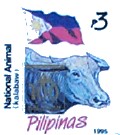 |
| Rice paddies. (84k)
|
|
 |
 |
| Mixed agriculture (107k)
|
|
 |
 |
| Carabao (102k) |
|
 |
 |
| Firewood. (99k) |
|
— Index —
|
Part 3: The Barangay
As we described in a previous article, the barangay is a government entity unique to the Philippines. The barangay of Calabacita is rural, agricultural, and remote. Although it is only about 27 km from the community of Jagna on the coast, communication is limited. Calabacita is, literally, at the end of the road — and the end of the bus line. There is no telephone service. Only one television station (Channel 2 from Manila) is available through a relay transmitter, but only in certain locations, and with a very high antenna.
Other than the barangay officials, who are elected from among the local residents, and the schools, there are no other government services here. There are no police officers or fire fighters in the barangay. Even the school administrator is located in Jagna, and visits here only twice a year.
There are two buses a day from Jagna and one from Tagbilaran, when the road is open. The bus trip is tedious, and can be expensive for poor farmers. Outsiders are not common. We were told that one foreigner had visited Calabacita about 5 years ago; he only stayed a few minutes and then left. We were the next to arrive.
We walked around a bit on our own. The only industry in the barangay is agriculture. The primary crop, of course, is rice. The rice fields are terraced, irrigated, and drained. The labor to build, maintain, and till them must be enormous. We saw no agricultural machinery in the fields. We did see a group of about 10 men tilling a small field. They had started work on the field when we drove by in the morning and had just finished when we went by again in the afternoon. They were resting in the shade, and waved at us as we passed.
  We did see carabao, or kalabaw, grazing by the side of the road. They are tied up with short ropes through their noses, and are often on the road — you have to be careful to drive around them. We have only seen one carabao harnessed to a plow, just outside our cottage in Panglao. We did see carabao, or kalabaw, grazing by the side of the road. They are tied up with short ropes through their noses, and are often on the road — you have to be careful to drive around them. We have only seen one carabao harnessed to a plow, just outside our cottage in Panglao.
There are about 300 residences in the barangay, each housing an extended family that could include as many as 10 people. The homes are scattered in small groups along the road and among the fields, with a larger number in the barrio at the heart of the barangay. We saw no automobiles, pickup trucks, or motorcycles.
In the more urban areas of Bohol Province, propane gas is commonly used for cooking. The brightly colored gas cylinders are everywhere. Here in the mountains, we did not see any propane cylinders at all. Instead, we saw many small piles of firewood stacked up in the sun along the road to dry.
And now, finally, we visit the barrio of Calabacita where Maria lives and teaches, in part 4.
-- return to the 2002 Journal Archive
|